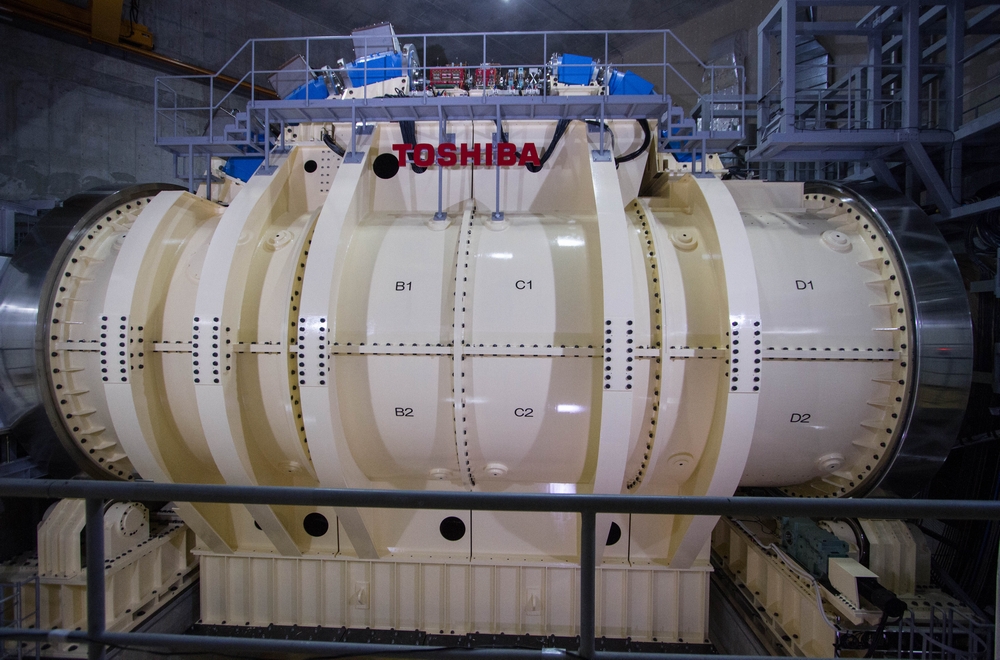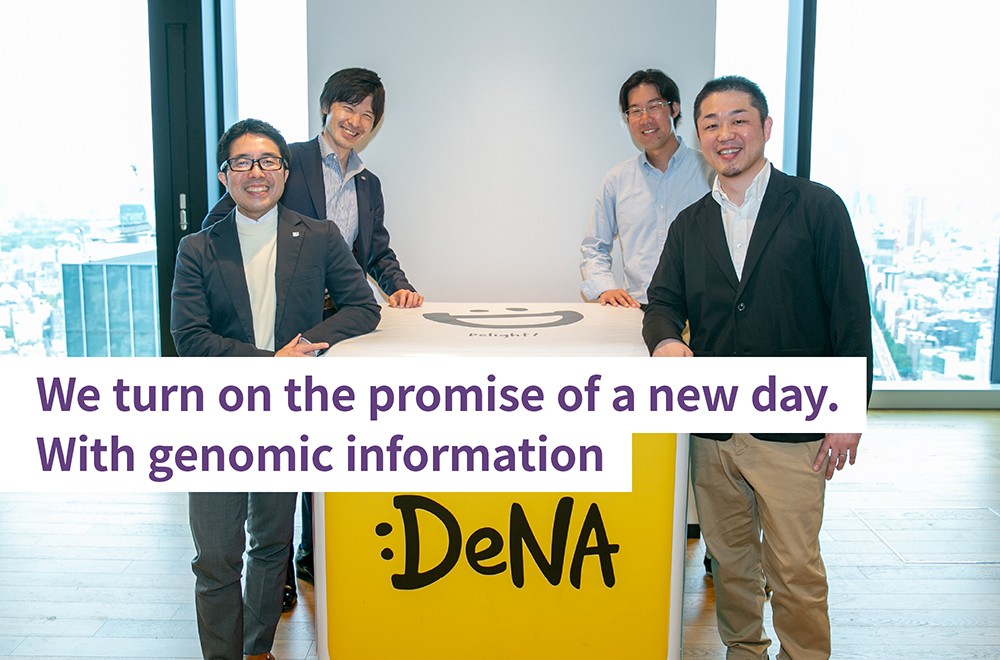Pinpoint Irradiation on Tumor – Opening Up New Possibilities in Cancer Treatment
2019/09/04 Toshiba Clip Team
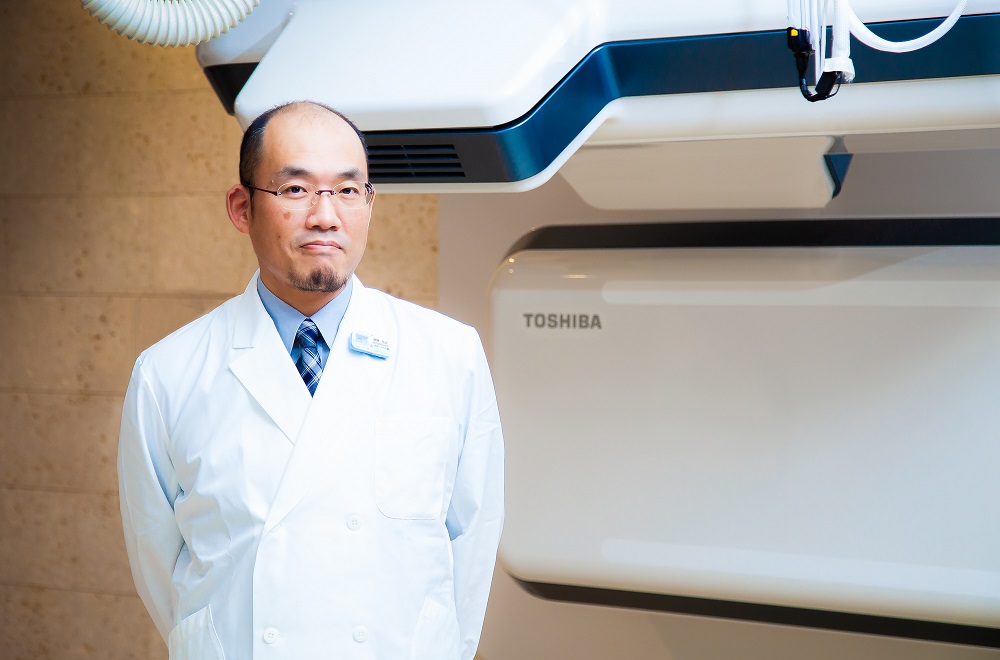
Cancer. It’s one of the most frightening words in any language, a diagnosis none of us want to hear. But in its various forms it’s the biggest killer in many of the world’s countries. In the US it hits nearly two out of five people, and in Japan even more, one in two.
Over many years, we have devoted more and more resources to researching and building an ever-stronger armory for fighting cancer, and today we widely deploy three main modes of treatment: surgery, to remove tumors; chemotherapy, the systemic application of anti-cancer drugs; and radiation therapy, which directly irradiates and destroys cancerous cells. Recently, the last of these has seen a notable advance, the development of heavy-ion therapy.
Radiation therapy has the unique ability to penetrate deep into the body, to reach locations hard to access surgically, while imposing fewer physical burdens on patients. There are different kinds of radiation, including X-rays and gamma rays and, beyond them, particle beam radiation, where the generated particles are heavier than electrons. This is further divided into proton-beam therapy and heavy-ion therapy, typified by the carbon-ion beam.
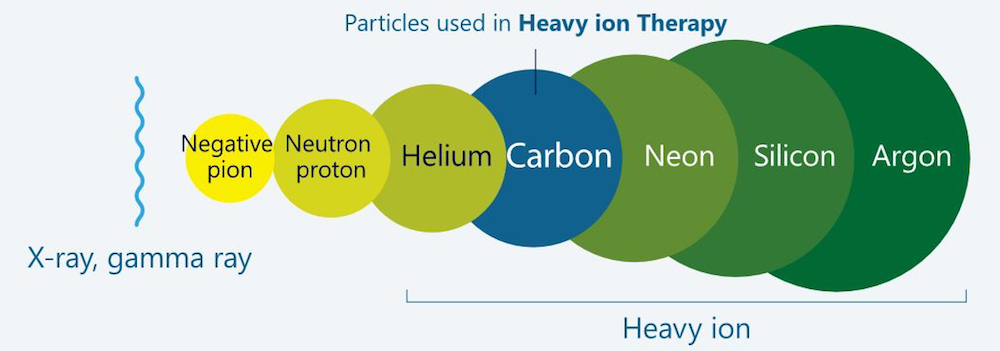
Comparison of particle sizes
Heavy-ion therapy is the most recent and the most potent radiation therapy. It uses an accelerator system housed in a room almost as big as a soccer field to push carbon ions to approximately 70% of the speed of light, and it delivers much higher levels of energy than an X-ray or proton beam. The dose is focused and concentrated, and precisely hits tumors with a clustering effect that damages cancer cells at the genetic level. It requires fewer sessions, and it achieves more.
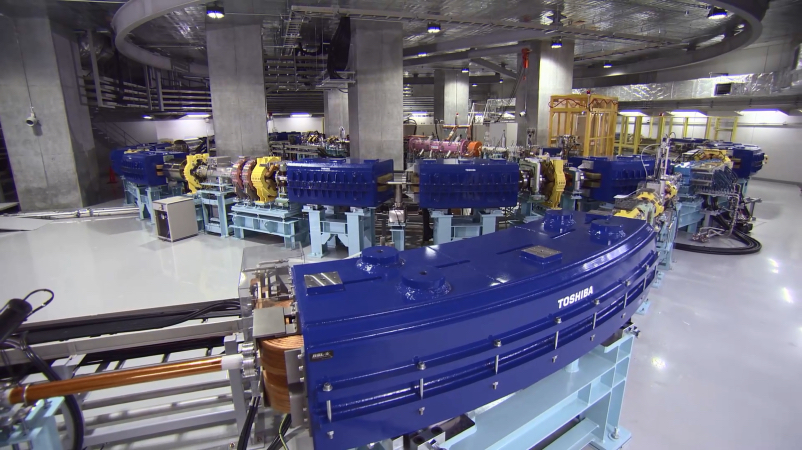
The ion-beam accelerator at the Radiation Oncology Center in Kanagawa (i-ROCK)
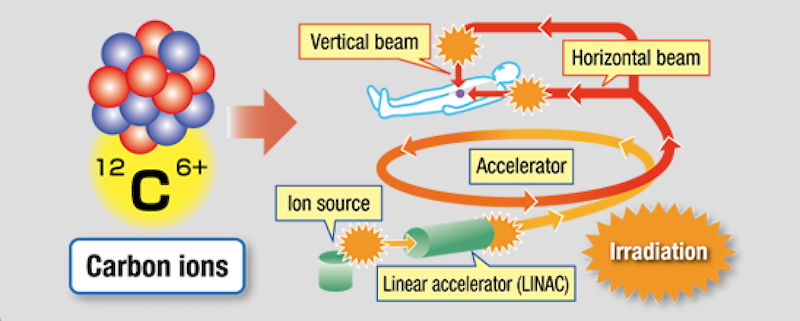
How the system works (Courtesy of i-ROCK)
How is this advanced therapeutic system used? We found out by visiting Kanagawa Prefectural Cancer Center, where Toshiba has supplied a system to i-ROCK, one of Japan’s newest heavy-ion therapy facilities. There, we spoke to Dr. Hiroyuki Katoh, Chief of Ion-beam Radiotherapy Division, Department of Radiation Oncology & Ion-beam Radiation Oncology Center.
Features of radiation therapy and the benefits of heavy-ion therapy
Radiation therapy takes advantage of differences between normal cells and cancerous cells to get high level therapeutic results, Dr. Katoh explained.
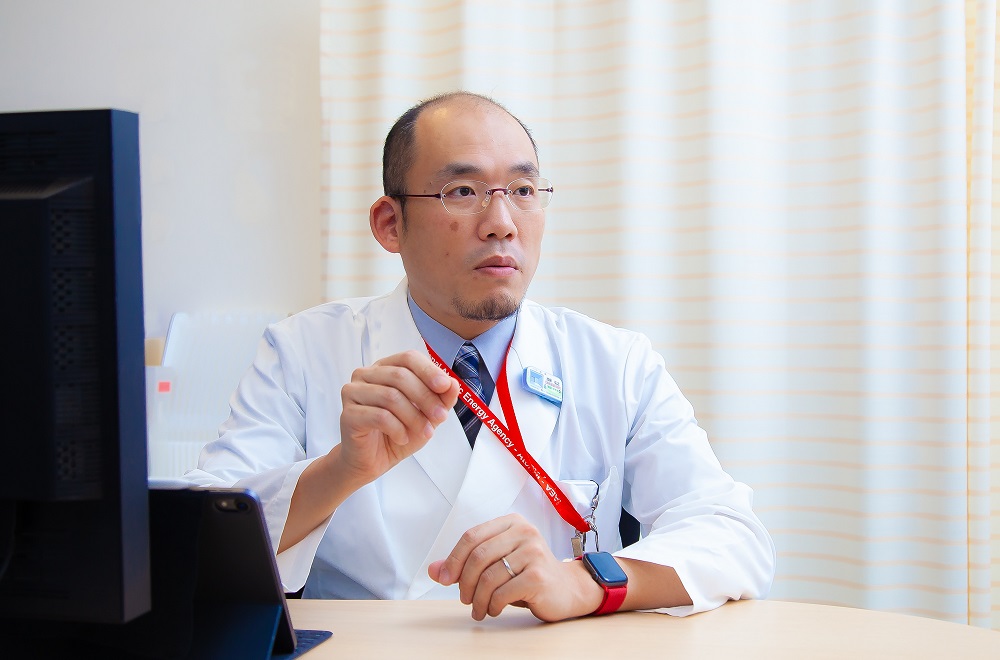
Dr. Katoh in his office
“Normally, cells proliferate during repeated division and DNA synthesis, and what we are targeting with radiation therapy is the cancer cells. They don’t die immediately when we irradiate them, but their DNA is damaged or broken, and they are unable to divide or replicate themselves. Healthy cells are different, and even if there is slight damage to their DNA they can repair themselves. Through repeated irradiation sessions, we gradually eliminate the tumor.
“Radiation therapy is very different from chemotherapy, the drug-based anti-cancer treatment that works on the whole body. And it is not a universal treatment for metastatic or recurrent cancers. It’s more like surgery, in that it treats a specific target area; but its great benefit is that it can treat patients without the damage that can result from surgery.”
Taking post-treatment quality of life assessments into account—the overall emotional, social and physical well-being of the individual in daily life after treatment—radiation therapy is recognized as patient-friendly.
We next asked Dr. Katoh about side effects, a well-documented concern in cancer treatment. Some surgical procedures can cause organs and body parts to lose functionality, and chemotherapy, which attack normal cells throughout the body, is known for its strong side effects and for sapping physical strength. His comments were encouraging.
“Radiation therapy destroys DNA with light, so there is almost no impact at the time of exposure. For comparison, the reaction is similar to sunburn, where there is a time lag before the appearance of any side effects. The possibility of the appearance of cancer or an impact on genes 10 to 20 years down the road from treatment is not zero, and we recognize that this is a concern for some patients, but estimates indicate very low level occurrence.”
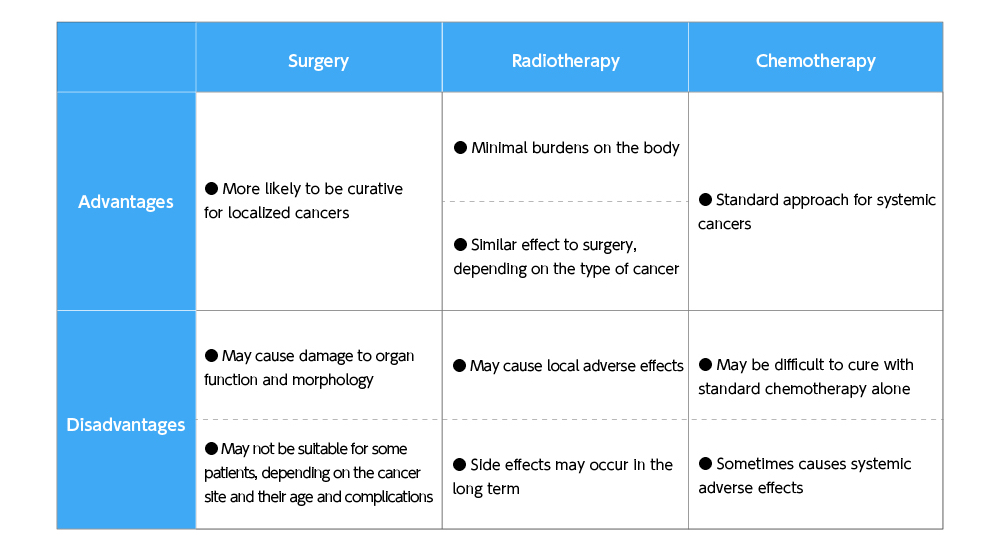
Comparison of three main treatments
In practical terms, all three mainstream cancer therapies have advantages and drawbacks, which is why they are routinely combined to provide optimum treatment. But which types of cancer are best treated with heavy-ion therapy?
“It’s very effective in dealing with sites of persistent cancers and where there is a reason for the patient not being able to undergo surgery, such as physical problems,” explains Dr. Katoh.
“Heavy ion therapy delivers a much more concentrated dose of radiation than other radiation therapies, and has the great advantage of minimizing irradiation of normal cells immediately surrounding the tumor. It is particularly effective in cases where other radiation systems cannot deliver adequate treatment—for example, on bone and soft tissue tumors. The benefits of heavy ion therapy in cases where surgical removal is not possible is now recognized worldwide, and great results are expected.”

X-ray (left) and heavy-ion beams (right). Heavy ion beams stop at the tumor, minimizing damage to normal tissue.
i-ROCK uses a novel three-dimensional scanning method that allows thin carbon-ion beams to irradiate multiple layers of a tumor site. This approach ensures pinpoint accuracy with a beam that is about three times more effective at destroying cancer cells than other radiation therapies.
Developed by Toshiba, the 3D scanning technology generates narrow, pencil-like beams, and quickly irradiates cancerous tumors as if filling in their outlines with a pen. The important gain here is that heavy-ion beam can be efficiently directed to tumors, even those with complex shapes. It is much more accurate than anything we had in the past.
This video was released on September 29, 2017
Pencil-like beam irradiation technology using Toshiba’s three-dimensional scanning method
“i-ROCK” offers the latest medical care and comfortable treatment rooms
Dr. Katoh joined the Kanagawa Prefectural Cancer Center in April 2018, and is happy to talk about the features of i-ROCK and how it brings together cutting-edge science and medical technology.
“Japan’s first heavy-ion therapy facility was the QST Hospital in Chiba Prefecture,” says Dr. Katoh, “though the main application there is research. Since the Heavy-Ion Medical Center at Gunma University, the third facility in Japan, attention to the patient’s comfort started to grow. i-ROCK, is one of the latest facilities in Japan, and is sophisticated in terms of facility design and patient’s comfort.”
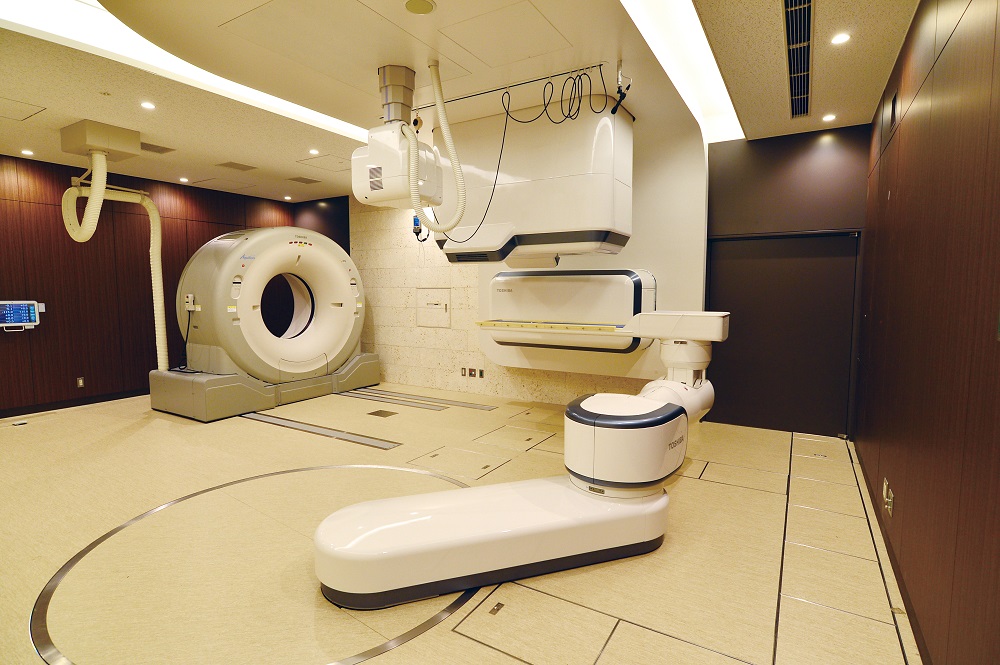
i-ROCK’s treatment room offers a comfortable environment
The patient’s couch in the treatment room rests on a 7-axis articulated arm that realizes smooth movement in all required directions. It was designed by Toshiba with a consideration towards patient comfort and peace of mind, and also for easy operation by medical staff. In radiation therapy, the overall comfort of the facility is a factor that cannot be ignored.
“Patients are anxious when they enter the treatment room,” says Dr. Katoh, “you can feel how tense they are. We don’t use anesthesia during the treatment, but it is important that patients hold their position and don’t move during irradiation. Their state of mind and anxiety can greatly affect treatment, and an environment that helps them to relax and feel safe leads to smoother treatment.
“An issue with heavy-ion therapy is that it still lacks an established track record, due to being new. For instance, we need to consider very carefully whether or not to apply it to small children. But I have no doubt that heavy-ion therapy will advance further, with progress in the technology. I think that one of the best parts of the treatment is the strong team work of doctors, medical physicists, radiologists, nurses, and other experts work.
“What I can say for sure as someone who works in radiotherapy, is that by having i-ROCK we can suggest what we consider to be the best treatment for each individual patient. From a doctor’s perspective, I am very grateful for that.”
As our meeting came to a close, Dr. Katoh left us with a last thought, expressed with deep conviction: “As we bring together the wisdom of science and medical practice, we are making steady progress to the future where we can save more patients.”
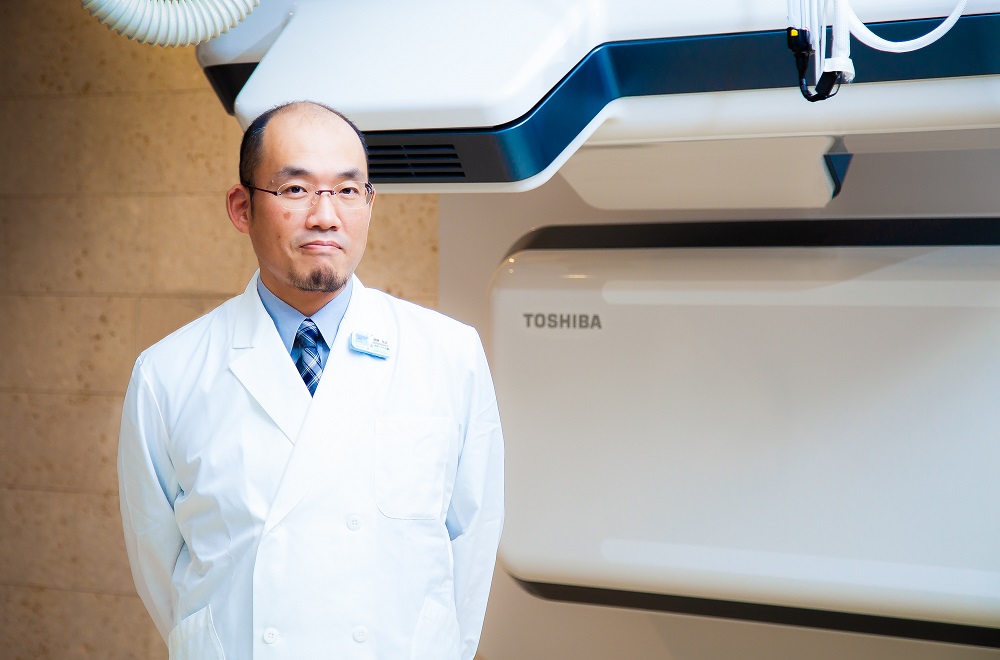
Dedicated to the highest quality of patient care
![]()





